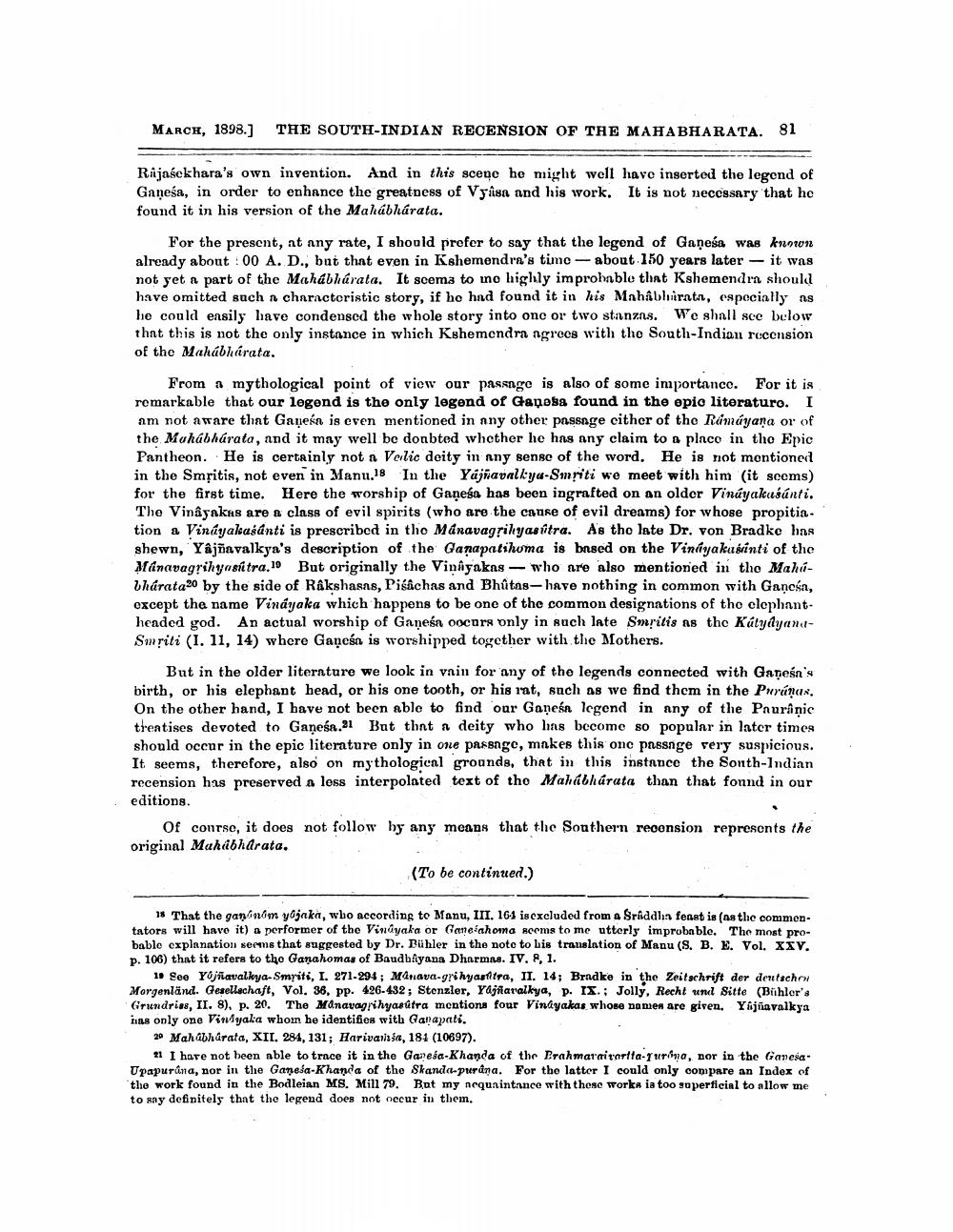________________
MARCH, 1898.) THE SOUTH INDIAN RECENSION OF THE MAHABHARATA. 81
Rijasekhara's own invention. And in this scene he might well have inserted the legend of Ganesa, in order to enhance the greatness of Visa and his work. It is not necessary that he found it in his version of the Mahabharata.
For the present, at any rate, I should prefer to say that the legend of Ganesa was known already about : 00 A.D., but that even in Kshemendra's time about 150 years later - it was not yet a part of the Mahabharata. It seems to ino highly improhnble that Kshemendra should have omitted such a characteristic story, if he had found it in his Mahabhirats, especially as he could easily have condensed the whole story into one or two stanzas. We shall see below that this is not the only instance in which Kshemendra agrecs with the South-Indian recension of the Mahabharata.
From a mythological point of view our passage is also of some importance. For it is remarkable that our legend is the only legend of Ganosa found in the opio literaturo. I am not aware that Ganesa is even mentioned in any other passage either of the Rámáyana or of the Mohábhárata, and it may well be donbted whether he has any claim to a placo in tho Epic Pantheon. He is certainly not a Veilic deity in any sense of the word. He is not mentioned in the Smritis, not even in Manu.18 In the Yájfiavalkyu-Smriti we meet with him (it sccms) for the first time. Here the worship of Gañesa has been ingrafted on an older Vináyakaśánti. The Vinayakas are a class of evil spirits (who are the cause of evil dreams) for whose propitia. tion a Vinúyakaránti is prescribed in tho Mánavagrikyasútra. As the late Dr. von Bradke has shewn, Yâjsavalkya's description of the Ganapatihuma is bnsed on the Viniiyakusrinti of the Manavagrilyasiltra.10 But originally the Vinayakas - who are also mentioned in the Mahibharata20 by the side of Rakshasas, Pisachas and Bhûtas- have nothing in common with Ganesa, except the name Vinayaka which happens to be one of the common designations of the elephantheaded god. An actual worship of Ganesa oocure only in such late Smritis as the KútydyanaSmriti (1. 11, 14) where Gaņeśn is worshipped together with the Mothers.
But in the older liternture we look in vain for any of the legends connected with Ganesn's birth, or his elephant head, or his one tooth, or his rat, such as we find them in the Purúnax. On the other hand, I bave not been able to find our Ganeśn legend in any of the Pauranic treatises devoted to Ganesa.21 But that a deity who has become so popular in later times should occur in the epic literature only in one passage, makes this one passage very suspicious. It seems, therefore, also on mythological grounds, that in this instance the South-Indian recension has preserved a loss interpolated text of tho Mahabharata than that found in our editions.
Of conrse, it does not follow by any means that the Southern recension represents the original Mahabharata.
(To be continued.)
13 That the gan inom yojnika, wbo according to Manu, III. 161 is excluded from a Sraddha feast is (as the commontators will have it) a performer of the Vinayaka or Ganesahoma seems to me utterly improbable. The most probable explanation seems that suggested by Dr. Bühler in the note to his translation of Manu (S. B. E. Vol. xxv. p. 106) that it refers to the Ganahomas of Baudbayana Dharmas. IV., 1.
1. Soo Yojiavalkya-Smriti, I. 271.294; Manava-grihyastitra, II. 14: Brndke in the Zeitschrift der deutsch Morgenländ. Gesellschaft, Vol. 36, pp. 426-432; Stenzler, Yajñaralkya, p. IX.; Jolly, Recht und Sitte (Bühler's Grundries, II. 8), p. 20. The Manavaprihyasutra mentions four Vinayakas whose names are given. Yajnavalkya as only one Viniyaka whom he identifies with Ganapati.
20 Mahabhürata, XII. 284, 131; Harivarissa, 181 (10697).
21 I have not been able to trace it in the Ganesa-Khanda of the Brahmaraitortta-Turina, nor in the GanesaUpapurúna, nor in the Ganesa-Khanda of the Skanda-purana. For the latter I could only compare an Index of the work found in the Bodleian MS. Mill 79. But my nequnintance with those worka ia too superficial to allow me to say definitely that the legend does not occur in thein.




